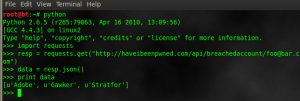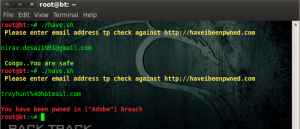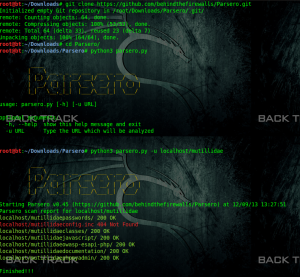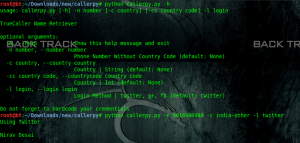SKYPE RESOLVER BASH SCRIPT
This is simple bash script which query skype username against http://resolveme.org/ and grab I.P.
sh skypersolver.sh
BASH SCRIPT FOR CHECKING HTTP HEADERS FOR SECURITY
For checking http header for security perspective you can visit Security Headers . It will check for following header.
Access Control Allow Origin
Content Security Policy
Cross Domain Meta Policy
NoSniff
Server Information
Strict Transport Security
UTF-8 Character Encoding
X-Frame-Options
X-Powered-By
X-XSS-Protection
Content Security Policy
Cross Domain Meta Policy
NoSniff
Server Information
Strict Transport Security
UTF-8 Character Encoding
X-Frame-Options
X-Powered-By
X-XSS-Protection
I wrote bash script which check HTTP header of website against securityheaders.com & give output.
chmod +x header.sh
./header.sh
BASH SCRIPT FOR CHECKING AN ACCOUNT THAT HAS BEEN COMPROMISED IN A DATA BREACH.
Troyhunt start great website for checking your email address has been compromised in data breach or not.Right now Adobe,Stratfor,Gawker,Pixel Federation,Yahoo!,Sony,Vodafone `s breach email address is listed. You can check it manually on their site.
I wrote simple bash script for checking against their site that email address has been compromised or not.You can also write in python using simple requests module.
Usage:-
git clone https://github.com/niravkdesai/haveibeenpwned.git
git clone https://github.com/niravkdesai/haveibeenpwned.git
cd haveibeenpwned
chmod +x haveibeenpwned.sh
./haveibeenpwned.sh
Please enter email address to check against http://haveibeenpwned.com
troyhunt%40hotmail.com
You have been pwned in [“Adobe”] breach
PYTHON SCRIPT FOR AUDITING ROBOTS.TXT
Before one year i wrote different methods to exploit robots.txt file; you can find it here. Sometimes, due to weak directory permission you can get into dis-allowed directory from robots.txt.This python script check the HTTP status code of each Disallow entry in order to check automatically if these directories are available or not.For Original article click here.
It require python3 and urlib3 module.
git clone https://github.com/behindthefirewalls/Parsero.git
cd Parsero
python3 parsero.py -h
python3 parsero.py -u localhost/mutillidae
cd Parsero
python3 parsero.py -h
python3 parsero.py -u localhost/mutillidae
Now you can see that which dis-allowed directory is allowed , it means for which we got HTTP-status code 200.
TRuECALLER NAME RETRIEVER PYTHON SCRIPT
Truecaller is a global phone directory application for smartphones and feature phones, and accessible via a Web site. If you have any unknown mobile number you can search in truecaller website or using truecaller application.Thispython script is written by A’mmer Almadani. Script is still in developing phase.More functions will be added soon.
cd callerpy
Now open caller.py file & enter your twitter credential in line 39,40. it will use for authentication.
python caller.py -h
usage: callerpy.py [-h] -n number [-c country] [-cc country code] -l login
TrueCaller Name Retriever
optional arguments:
-h, –help show this help message and exit
-n number, –number number
Phone Number Without Country Code (default: None)
-c country, –country country
Country | String (default: None)
-cc country code, –countrycode country code
Country | Int (default: None)
-l login, –login login
Login Method | twitter, g+, fb (default: twitter)
-h, –help show this help message and exit
-n number, –number number
Phone Number Without Country Code (default: None)
-c country, –country country
Country | String (default: None)
-cc country code, –countrycode country code
Country | Int (default: None)
-l login, –login login
Login Method | twitter, g+, fb (default: twitter)
python callerpy.py -n 9016986989 -c india-other -l twitter
PYTHON sCRIPT TO SEARCH EMAIL ADDRESSES AGAINST THE GRAVATAR DATABASE.
Gravatar is a service for providing globally unique avatars.When the user posts a comment on such a blog that requires an e-mail address, the blogging software checks whether that e-mail address has an associated avatar at Gravatar. If so, the Gravatar is shown along with the comment.Script is made by averagesecurityguy . Our script take email address & check against gravatar database , if email address is exist , then extract username , location, accountdetail.First we will understand how it`s work , for developer resources click here.
To view details of email address ; we need to create email hash of address. For example , if you want to check email address nirav.desai1991@gmail.com. We have to create md5 hash of email address.
root@bt:~#echo -n nirav.desai1991@gmail.com| md5sum
dfd36ad92895ea6b7829d2918ad07fcf
dfd36ad92895ea6b7829d2918ad07fcf
To extract details about email address we have to make following request
http://en.gravatar.com/dfd36ad92895ea6b7829d2918ad07fcf.json
http://en.gravatar.com/dfd36ad92895ea6b7829d2918ad07fcf.json
And there we can get details about my gravatar profile.
It`s just simple details how it`s work. Now we will go to script, Gravatar.py takes a file with a list of email address, one on each line, and searches Gravatar for information about the email address. If address is registered with Gravatar, then selected data points are extracted from the Gravatar profile.
Now you need email address list file .
python gravatar.py email
CLOUDFLARE RESOLVeR BASH SCRIPT
CloudFlare is a content delivery network and distributed domain name server service marketed as improving website performance and speed and providing security. Before one year i posted different methods to find out real I.P. behind cloudflare.
All those methods are only working , if there is admin misconfiguration.
(1)DNS bruteforce
(2)NMAP
(3)Netcraft toolbar
I made simple bash script which do all things for you, you just have to provide name of website which is behind cloudflare.
cd cloudflare-ip
chmod +x cloudflare-ip.sh
./cloudflare-ip.sh
In script you have to change I.P. in line 45 . i used dns variable , because for unknown DNS my isp redirect to its address ,so we can know that response is valid or not.Change that I.P. according to your setting.
BANNER GRABBING PYTHON SCRIPT
This is simple banner grabbing python script which can grab service banner of ports 21,22,25,80,110,443. If you want to grab banner of different ports ;you can modified it as per your requirement.
#!/usr/bin/python
import socket
import socket
def retBanner(ip, port):
try:
socket.setdefaulttimeout(2)
s = socket.socket()
s.connect((ip, port))
banner = s.recv(1024)
return banner
except:
return
try:
socket.setdefaulttimeout(2)
s = socket.socket()
s.connect((ip, port))
banner = s.recv(1024)
return banner
except:
return
def main():
portList = [21,22,25,80,110,443]
for x in range(147, 150):
ip = ‘192.168.95.’ + str(x)
for port in portList:
banner = retBanner(ip, port)
if banner:
print ‘[+] ‘ + ip + ‘ : ‘ + banner
for x in range(147, 150):
ip = ‘192.168.95.’ + str(x)
for port in portList:
banner = retBanner(ip, port)
if banner:
print ‘[+] ‘ + ip + ‘ : ‘ + banner
if __name__ == ‘__main__’:
main()
main()
First we import socket library to script. Then we defined two function (1)retBanner (2)main
(1)retBanner:-
socket.setdefaulttimeout(2) indicate that default timeout of socket is 2 second.
s = socket.socket() indicate that we open socket.
s.connect((ip, port)) indicate that connect socket to specific i.p. and specific port.
s.recv(1024) read next 1024 bytes of socket & save it value to variable banner.
(2)main:-
portList = [21,22,25,80,110,443] :- grabbing banner of these ports.If you want to grab more port just add port number in portList array.
for x in range(147, 150): :- It is used for grab banner of block of i.p. It only change fourth octet of i.p. address. Change value according to your requirement.
ip = ‘192.168.95.’ + str(x) :- we defined first three octet of i.p. ;& fourth octet is come from for loop.
for port in portList: :- Scan one by one port from array portList.
banner = retBanner(ip, port) : we called first function retBanner & saved it value to variable banner.
And last two line indicate that if we got banner than print on screen with i.p. : banner.
(3)if __name__ == ‘__main__’: It indicate that hat our Python files can act as either reusable modules, or as standalone programs.
And last line of calling of main function.
Usage of script
chmod +x script_name
python script_name
chmod +x script_name
python script_name
PORT SCANNING SHELL SCRIPT
Here is the code for a simple port scanner constructed with bash. The script takes three arguments: a host name or I.P. address, the port at which we wish to start our scans, and the port at which we wish to stop our scans.But before this you have to add /dev/tcp/ support to bash.
#!/bin/bash
#populate our variables from the arguments
host=$1
startport=$2
stopport=$3
#function pingcheck ping a device to see if it is up
function pingcheck
{
ping=`ping -c 1 -w 10 $host | grep bytes | wc -l`
if [ “$ping” -gt 1 ];then
echo “$host is up”;
else
echo “$host is down quitting”;
exit
fi
}
#function portcheck test a port to see if it is open
function portcheck
{
for ((counter=$startport; counter<=$stopport; counter++))
do
(echo >/dev/tcp/$host/$counter) > /dev/null 2>&1 && echo “$counter open”
done
}
#run our functions
pingcheck
portcheck
#populate our variables from the arguments
host=$1
startport=$2
stopport=$3
#function pingcheck ping a device to see if it is up
function pingcheck
{
ping=`ping -c 1 -w 10 $host | grep bytes | wc -l`
if [ “$ping” -gt 1 ];then
echo “$host is up”;
else
echo “$host is down quitting”;
exit
fi
}
#function portcheck test a port to see if it is open
function portcheck
{
for ((counter=$startport; counter<=$stopport; counter++))
do
(echo >/dev/tcp/$host/$counter) > /dev/null 2>&1 && echo “$counter open”
done
}
#run our functions
pingcheck
portcheck
We can divide this script in three parts.
(1)In first part we populate variable for argument ;variable $0 is reserved for script name . ./scriptname host startport stopport
So host value saved in variable 1 ;start port value is saved in variable 2 & stop port value is saved in variable 3.
(2)Second part is ping check function.
We defined ping check function to determine host is up or not. Here we use pipe for giving previous command output to next command.
ping -c 1 -w 10 $host | grep bytes | wc -l
-c 1 is indicated that we only transmitted 1 packet .
-w 10 is indicated timeout value is 10 seconds.
If host is up then we got some response like
PING 127.0.0.1 (127.0.0.1) 56(84) bytes of data.
64 bytes from 127.0.0.1: icmp_seq=1 ttl=64 time=0.056 ms
64 bytes from 127.0.0.1: icmp_seq=1 ttl=64 time=0.056 ms
— 127.0.0.1 ping statistics —
1 packets transmitted, 1 received, 0% packet loss, time 0ms
rtt min/avg/max/mdev = 0.056/0.056/0.056/0.000 ms
1 packets transmitted, 1 received, 0% packet loss, time 0ms
rtt min/avg/max/mdev = 0.056/0.056/0.056/0.000 ms
Now this output is redirected to input of next command which is grep bytes ,it used for searching ; so it will only take line which has bytes so out put of that is
64 bytes from 127.0.0.1: icmp_seq=1 ttl=64 time=0.056 ms
Next this is applied to wc -l which is used for counting line ; so output is one because we have only one line output of previous command.
So final value is 1 ;this value is stored into the variable name ping
Now we used simple if statement which check value in ping variable i value is greater than 1 than host is up otherwise down because if host is down than we don`t get response which contain bytes so no grep output & hence line is zero & value in variable ping is also zero.
(3)Third part is port scanning function
First is for loop ;it will running for start port to stop port which we have to specified in argument while running of script.So if we specified start port =80 ;stop port =85 then for loop will run from 80 to 85 to check open port.
Next is (echo >/dev/tcp/$host/$counter) > /dev/null 2>&1 && echo “$counter open”
Here we are redirect output of /dev/tcp/$host/$counter (Which actually check port is open or not) to /dev/null(Which is null file).2>&1 is used to display error message.And final output is display on screen.
And in last two line we called function which we defined in part 2 & part 3.
Usage of script:
chmod +x script_name.sh
./script_name host start_port stop_port
We can also scan multiple I.P. by reading I.P. from file.









0 comments:
Post a Comment